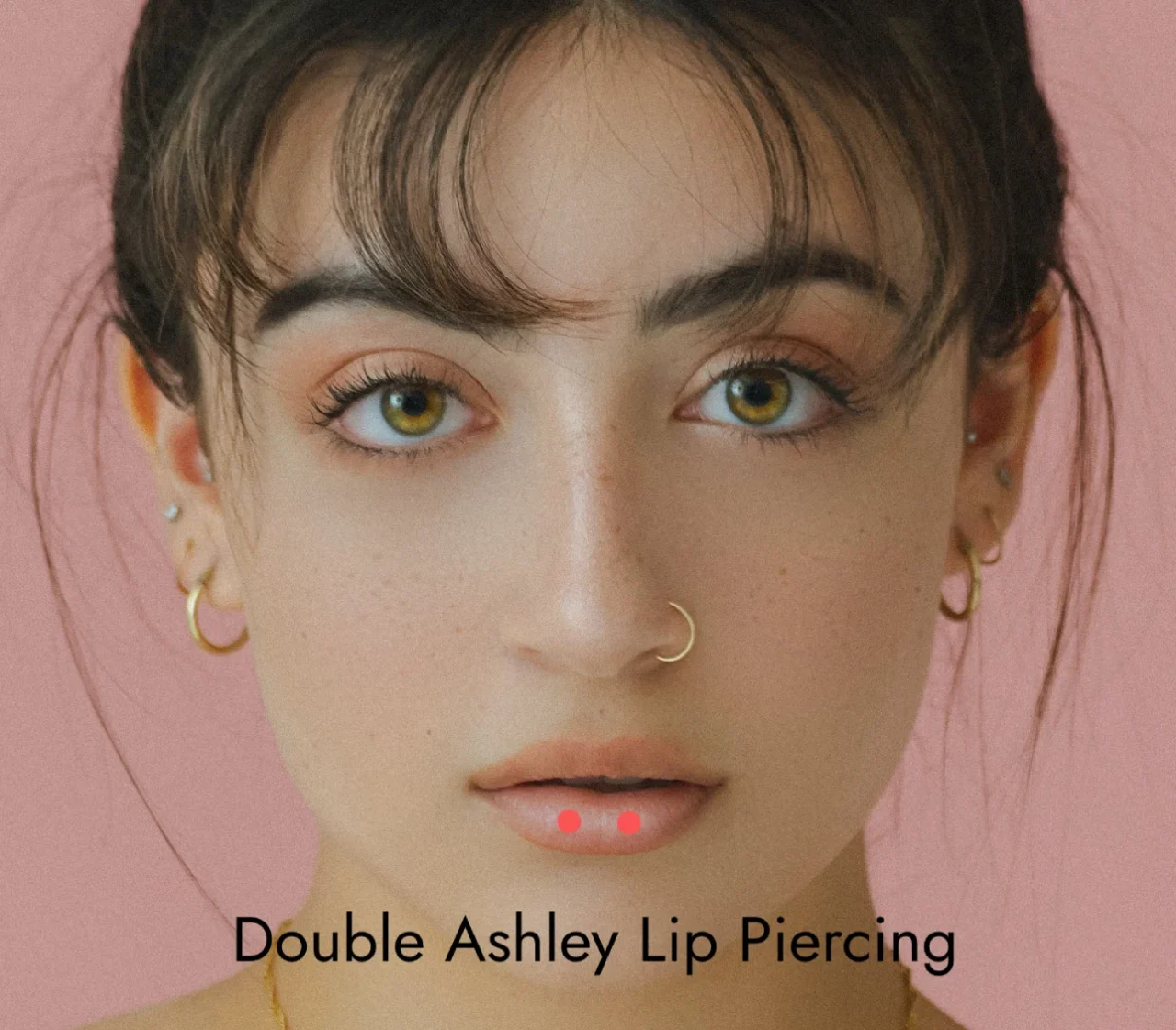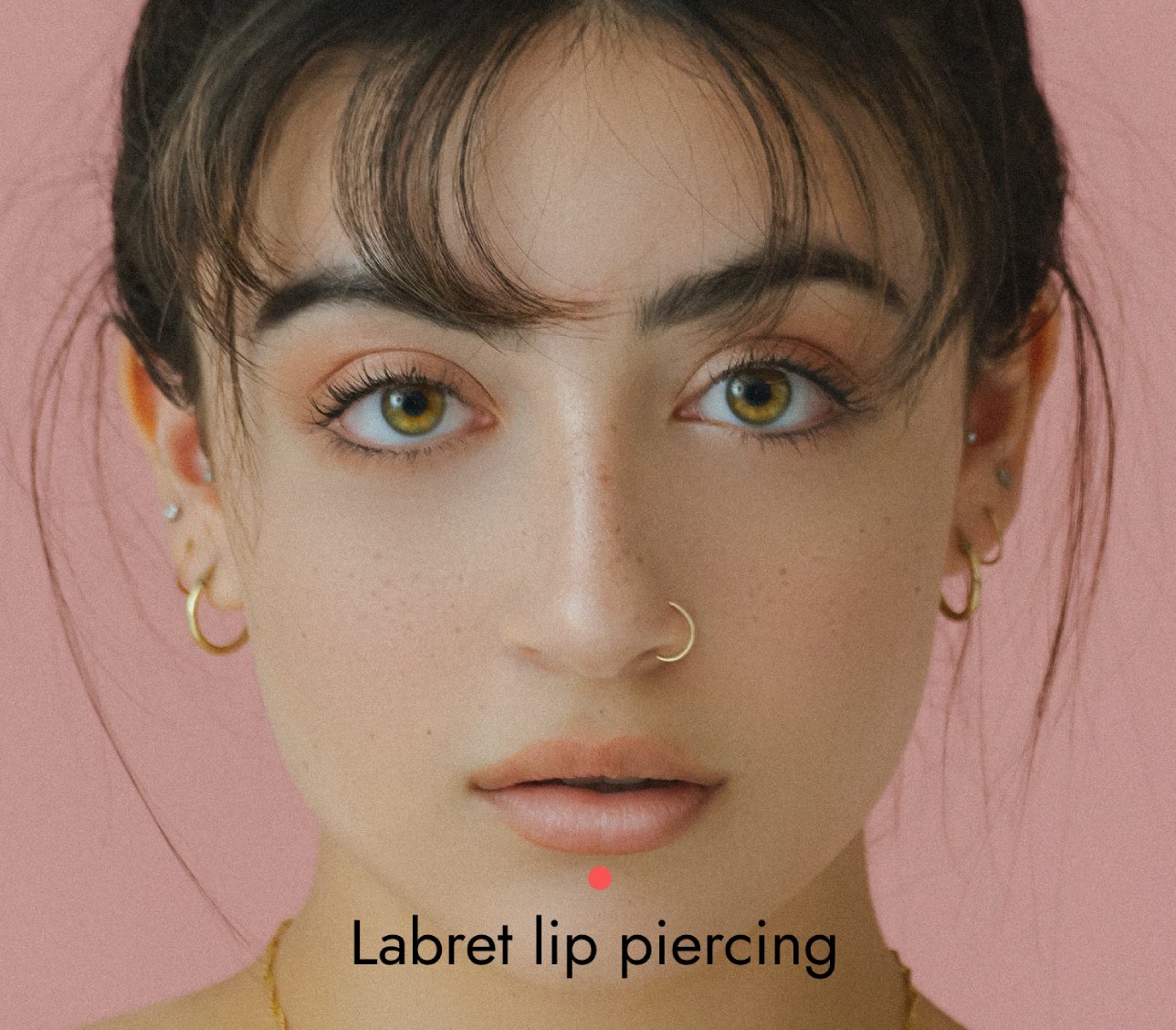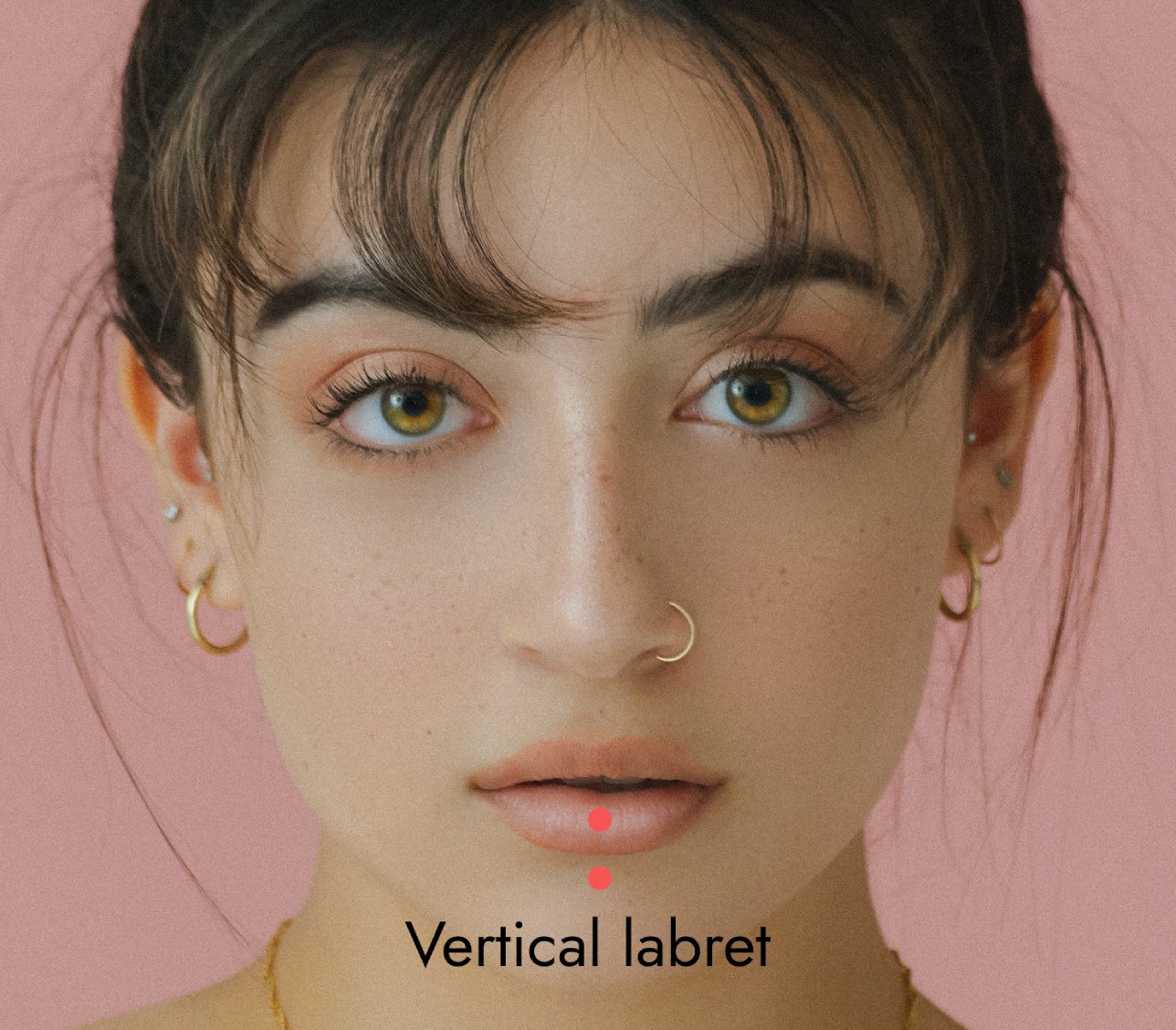What’s an Ashley Piercing: Healing, Pain, Cost, Jewelry, Pros, and Cons

Fast Facts:
- Placement: It goes through the center of the bottom lip.
- Cost: $30-$80.
- Pain: A high pain level. It is rated at 6 on a scale of 1 to 10.
- Healing time: 8-10 weeks. It takes 4 months at minimum to heal completely.
- Jewelry: Labret studs.
- Risks: Teeth damage, scars, infections, and swelling.

What's an Ashley Piercing?
The Ashley lip piercing is a single piercing to the center of the bottom lip and an exit at the back of the lip. It is commonly pierced with studs, has a high pain level, and tends to draw attention to the lower lip. It is also known as the inverted vertical labret.
Ensure that you get a professional to do this piercing since it needs correct placement to avoid damage to the nerve endings, gums, veins, and teeth.
Ashley Piercing Healing Time
Within 8 to 10 weeks, the piercing will start to heal, although the inner part of the lip may take a bit longer. And it takes 4 months at minimum to heal completely.
Ashley Piercing Pain
The pain is rated at 6 on a scale of 1 to 10. This piercing has a high pain level, mainly because it entails the perforation of a large part of the lip tissue and swelling after the piercing.

Ashley Piercing Price
The cost mostly depends on the location and the price of the jewelry. Most stores charge between $30-$80. Some websites list their charges, and it would be wise to go through them before visiting the store.
Ashley Piercing Pros and Cons
Pros:
- One of the most common and popular lip piercings.
- It has a look that's both delicate and noticeable.
- It makes your face look centered.
Cons:
- You have a limited selection of jewelry for this piercing.
- Since it's around your mouth, it's relatively easy for it to get infected.
- The piercing touches your teeth or gums.
- This piercing can be painful.
- Not everyone can get this piercing; you need to have the anatomy to support it.
- It's noticeable and pretty much impossible to hide
Variants
1. Double Ashley Piercing

2. The Labret Piercing

The Labret piercing is common, and the piercing studs get their names from it. The style is a single perforation of the central part below the bottom lip—people who experience the labret rate the pain in the lower end of the pain scale.
In eight weeks, the wound from the piercing should have healed. Most people prefer the 14 gauge (1.6 mm) with a length of 3/8 inches (10 mm). The style is versatile, and you can opt for a piece of flat-back stud jewelry, captive beads rings, or a circular barbell.
3. The Vertical Labret Piercing: Ashley Piercing vs. Vertical Labret

A Vertical Labret piercing is a distinct form of Labret piercings. The piercing runs from the middle of the bottom lip to the outer and upper surface of the lower lip. In this type of piercing, the ends of the jewelry are visible from both sides.
An individual should expect a sharp pain that subsides in a short time. Within six to eight weeks, the piercing will start to heal. However, it takes four months at minimum to heal completely.

The curved barbell (banana barbells) is most suitable for a Vertical Labret piercing as it curves and fits the natural shape of an individual’s lip. The gauge can be a 14 gauge (1.6 mm) or 16 gauge (1.2 mm) which may be 8 mm (5/16") to 12 mm long depending on your lips.
Ashley Piercing on Small Lips
Not everyone has the anatomy for an Ashley piercing. It's generally easier for a piercer to perform this piercing on someone with full lips. This is especially true if the lower lip curves outward.
That said, if you have thinner lips, it might be possible for you to get an Ashley piercing. Make sure you consult an experienced piercer. They can take a look at your anatomy and tell you whether or not you can safely get such a piercing.
Ashley Piercing Jewelry Size
1. What Gauge Is an Ashley Piercing?
16 gauge (1.2 mm in thickness) and 14 gauge (1.6 mm) are most suitable for the Ashley lip piercing. For this piercing, experts often use a slightly larger needle to make healing easier.
2. Ashley Piercing Bar Length
8 mm (5/16") is the most common bar length for Ashley lip piercings. However, depending on the thickness of your lip, the bar may be 6 mm (1/4") to 12 mm (1/2") long. If you are unsure what size to use for your lip piercing, consult with the piercer.
Ashley Piercing Jewelry

Implant-grade titanium minimalist stud $16.90, SHOP NOW.
The most common piece of jewelry for this piercing is the labret stud, designed from implant-grade titanium, 14 carats or higher of gold, surgical stainless steel, and pure sterling silver.
Labret studs are also known as flatback studs or flat disc studs. The studs are designed to give a comfortable feel in the mouth as it has a flat back on one of its ends and an accessory such as a ball, charm, or stone on the other end that is threaded.
It is designed with consideration to fit and get into contact with the lip and gums, and teeth.
The studs can display both sides of the jewel, with one end of the stud having threads and the other with a design. They have the advantage of better healing for the piercings and are designed with safe materials that mean they are good for health.
Pros:
- They heal relatively quickly
- They don't cause much discomfort
- They aren't extremely noticeable
Cons:
- They can come out more easily than lip rings
- If not cleaned regularly, they can get infected
Best Metals for Ashley Lip Piercings
1. Implant-Grade Titanium

Gold ashley piercing with three diamonds $22.9, SHOP NOW.
Titanium is an element that is completely hypoallergenic, so it's probably the best material for piercings, especially if you have sensitive skin.
Implant-grade titanium is the purest form and will not change or corrode if it's exposed to skin or bodily fluids. Implant-grade titanium jewelry is durable, hypoallergic, lead-free, nickel free, and non-corrosive.
Price Range: About $10-$20.
Pros:
- Approved by the Association of Professional Piercers
- Won't cause allergic reactions
- Is scratch-resistant and won't fade
Cons:
- Not as valuable as gold, silver, or platinum
- Doesn't sparkle quite as much as other metals
2. 14K or 18K Gold
If you're looking for a glittering, valuable metal for your piercing, either 14K or 18K gold may be your answer.
It is also one of the best metals for piercings that are highly recommended not only by piercing experts but also doctors. Its excellent quality of being inert makes it suitable for first piercings.
However, gold is a fairly soft metal, so it doesn't stand up to scratches and excessive wear. Compared to 14K gold, 18K gold is more prone to being affected by everyday use as it is softer and is closer to being pure 24K gold.
Both of these metals include other metal types in order to make them stronger. In order to avoid skin reactions, look for nickel-free metals.
Price Range: About $30-$200.
Pros:
- One of the most valuable materials
- Will not easily tarnish
- Offers plenty of sparkle
- Is easy to engrave or use to set stones
Cons:
- May contain non-hypoallergenic metals
- 18K gold in particular is not very scratch-resistant
3. Platinum
Platinum is a precious metal, so it's one of the pricier options on the list. It's completely hypoallergenic, so it's safe for even very sensitive skin. Its brilliant luster makes it a good choice for those seeking a sparkly, high-end look.
Price Range: About $40-$200.
Pros:
- Hypoallergenic and non-reactive
- Has a brilliant shine
- Is a very valuable material
Cons:
- Is a lot heavier than other metals
- It's uncommon, so your jewelry choices might be limited
4. Surgical Stainless Steel
Lots of new piercings are done in stainless steel. This material is affordable and typically doesn't cause reactions. However, it contains a small amount of nickel, so if you have a nickel allergy, it might be best to choose something else.
It is incredibly resistant to corrosion and will keep its shine for years.
If you're considering steel, 316L or 316 LVM steel is probably your best choice. Both names stand for the same surgical steel material, but the "VM" stands for"vacuum melt," or the way the steel is produced.
Price Range: About $10-$40.
Pros:
- Very affordable
- Common enough that you'll have plenty of jewelry choices
- Extremely durable and resistant to damage and corrosion
Cons:
- May cause reactions in those with nickel allergies
- Not considered as valuable as some other materials
When Can I Change My Ashley piercing?
You can change it after 2 months, but it is safer to wait till 4 months, when it is completely healed. Go to the piercer to change the piercing for the first time. They can show you how to do it safely.
How to Clean Ashley Piercing?
- It is recommended to use sterile saline that you buy from the store, rather than homemade saline, for cleaning your piercings. Homemade saline may be too salty for delicate piercing sites, leading to dryness and delayed healing.
- Using mild, fragrance-free soap and water to clean your piercing site is also an option.
- If you prefer homemade salt solution. You can start by mixing 1/2 teaspoon of non-iodized salt with one cup of distilled or boiled (for at least 20 minutes) water. You may choose to use less of the salt mixture like 1/4 to 1/8 teaspoon if you want a weaker solution that’s less likely to burn or sting. Stir the solution until it dissolves.
- If you see signs of infection, you can also use antiseptic solutions, such as betadine, isopropyl alcohol, or diluted hydrogen peroxide. However, avoid using them for daily cleaning as they can damage cells.
- Soak a cotton ball in the solution and dab it around the piercing site. Don't remove the jewelry!
- Take clean gauze or tissue and pat the area dry.
Your piercer should give you detailed instructions on keeping your piercing clean once the piercing has been placed.
Ashley Piercing Aftercare
- Opt for soft foods that aren’t overly spicy or acidic.
- Chew very carefully to avoid biting your lip jewelry.
- Avoid strenuous activities with your mouth until your piercings are fully healed.
- Avoid mouthwash with alcohol.
- Take care to avoid contaminating the piercing.
- Avoid touching it or applying makeup very close to it.
- Avoid getting in the water that might be dirty.
- Clean your piercing twice per day using a saline solution made for wound cleaning or soap and water to prevent infection.
- Avoid ointments as they prevent necessary air circulation.
- And of course, make sure to avoid snagging on clothes or towels.
- Wear loose clothing. Avoid wearing tight clothing or clothing that may rub against the piercing, as this can cause irritation and slow down the healing process.
- Use hypoallergenic jewelry like implant-grade titanium and 14- or 18-karat gold. Surgical-grade steel may contain small amounts of nickel that could cause allergic reactions.
- Don't move the piercing unless you're cleaning it. Pulling on a piercing early in healing is painful, but it also can get in the way of healing or damage the piercing itself.
- Wait until your piercing heals before changing out your jewelry.
- Watch for potential signs of infection and consult your piercer or doctor if it becomes infected.
Read More
Infected Ashley Piercing: What Does It Look Like and How to Treat It?
Vertical Labret Piercing: Placement, Healing, Pain, Price, Jewelry, Sizes, Aftercare

















